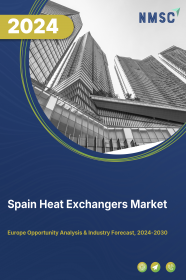
Spain Heat Exchangers Market by Type (Shell & Tube, Plate & Frame, Air Cooled, and Others), by Material (Metals, Alloys, and Brazing-CLAD), and by End User (Chemical, Energy & Power, Heating, Ventilation, Air Conditioning, and Refrigeration (HVACR), Food & Beverage, Pulp & Paper, and Others)– Opportunity Analysis and Industry Forecast, 2024–2030
Industry: Retail and Consumer | Publish Date: 03-Dec-2024 | No of Pages: 118 | No. of Tables: 86 | No. of Figures: 51 | Format: PDF | Report Code : RC1541
US Tariff Impact on Spain Heat Exchangers Market
Trump Tariffs Are Reshaping Global Business
Market Overview
The Spain Heat Exchangers Market size was valued at USD 277.6 million in 2023, and is predicted to reach USD 389.9 million by 2030, with a CAGR of 4.4 % from 2024 to 2030.
Heat exchangers are devices engineered to transfer heat from one fluid to another without direct fluid contact, extensively employed across industrial, commercial, and residential sectors, including HVAC systems and refrigeration units, to efficiently heat or cool fluids or air. They operate by permitting heat to traverse a barrier, such as a solid wall or a series of plates or tubes, and can be utilized for tasks such as heating water in a boiler or cooling air in an air conditioning system.
These devices come in various designs tailored to specific needs, ranging from simple radiator coils to complex systems found in chemical processing plants and power generation facilities. They play a vital role in multiple industries and applications, regulating air temperature in buildings, facilitating steam production in power plants, controlling temperatures during chemical reactions, and aiding in food processing, among other uses. Additionally, they are indispensable components in automotive cooling systems and have widespread applications in aerospace, marine, and wastewater treatment industries, contributing significantly to efficient thermal management and energy transfer.
Growing Demand for Renewable Energy Drives Spain’s Market Expansion
The growing demand for renewable energy is a key driver of market expansion in Spain. As the country prioritizes sustainability and seeks to reduce its reliance on fossil fuels, there is a significant increase in the adoption of renewable energy sources such as solar, wind, and hydroelectric power.
Heat exchangers play a crucial role in this transition by facilitating the efficient capture, storage, and utilization of heat generated from renewable energy sources. By integrating heat exchangers into renewable energy systems, Spain can enhance overall system efficiency and optimize energy utilization.
This growing demand for renewable energy solutions drives the need for innovative heat exchangers technologies tailored to the requirements of Spain's renewable energy sector. As a result, heat exchangers manufacturers are presented with lucrative opportunities to meet the rising demand and contribute to the country's sustainable energy future.
Stringent Government Regulations Regarding Energy Efficiency Boost Market Expansion
Stringent government regulations regarding energy efficiency serve as a catalyst for market expansion. These regulations are designed to promote sustainable practices and reduce energy consumption across various industries. By imposing requirements and standards for energy-efficient technologies, including heat exchangers, governments incentivize businesses to invest in innovative solutions that minimize energy wastage and environmental impact.
Compliance with these regulations often necessitates the adoption of advanced heat exchanger technologies that enhance energy efficiency and reduce greenhouse gas emissions. As a result, manufacturers in the heat exchangers market are compelled to develop and offer high-performance, energy-efficient solutions to meet regulatory requirements and capture market demand. Thus, stringent government regulations play a crucial role in driving market expansion by fostering the adoption of energy-efficient heat exchangers across industries.
High Installation and Maintenance Costs Restrain Market Growth
High installation and maintenance costs act as a deterrent to market growth. While heat exchangers offer efficient heat transfer solutions, the initial investment required for installation and ongoing maintenance expenses can be substantial. This financial burden often discourages businesses, particularly those with limited financial resources, from adopting heat exchangers technologies.
Additionally, despite the long-term cost savings offered by energy-efficient heat exchangers, the need for regular maintenance and operational expenses, such as cleaning and repairs, further adds to the overall cost of ownership. As a result, the perceived financial barrier associated with high installation and maintenance costs impedes the widespread adoption of heat exchangers, thereby restraining market growth in specific sectors.
Advancements in Cutting-Edge Materials and the Rising Trend of Industry 4.0 Create a Market Opportunity
The integration of advanced materials such as graphene and advanced ceramics represents a significant advancement in heat exchangers technology. These materials possess exceptional properties, such as high thermal conductivity and corrosion resistance, which hold significant potential for improving efficiency, durability, and overall performance across various industries such as HVACR, automotive, aerospace, and renewable energy. Utilizing these unique attributes, heat exchangers can facilitate more efficient heat transfer and better withstand challenging operating conditions, thereby enhancing reliability and extending lifespan.
Furthermore, the adoption of advanced materials can lead to reduced energy consumption and prolonged service life, offering substantial benefits in terms of operational efficiency and sustainability across different sectors.
Additionally, the rise of Industry 4.0, characterized by the integration of automation, data exchange, and digital technologies in manufacturing processes, presents additional opportunities for advancing heat exchangers technology. Through enhanced monitoring, control, and optimization enabled by Industry 4.0 technologies, heat exchangers can achieve increased efficiency and productivity.
As a result, the synergy between advanced materials and Industry 4.0 innovations is expected to drive innovation and expansion in the heat exchangers market, delivering improved performance and sustainability across a broad range of industrial applications.
Competitive Landscape
Several market players operating in Spain’s heat exchangers market include Alfa Laval AB, Johnson Controls International plc, Carrier Global Corporation, Lennox International Inc., Trane Technologies plc, API Heat Transfer Inc., Kelvion Holding GmbH, Xylem Inc., Danfoss Group, and General Electric Company among others. These companies are adopting various strategies such as product launches to remain dominant in the heat exchangers market.
Key Market Segments
By Type
-
Shell & Tube
-
Fixed Tube Heat Exchangers
-
U-Tube Heat Exchangers
-
Floating Head Heat Exchangers
-
Other Shell & Tube Heat Exchangers
-
-
Plate & Frame Heat Exchangers
-
Gasketed Plate & Frame Heat Exchangers
-
Welded Plate & Frame Heat Exchangers
-
Brazed Plate & Frame Heat Exchangers
-
Other Plate & Frame Heat Exchangers
-
-
Air Cooled
-
Forced Draft Heat Exchangers
-
Induced Draft Heat Exchangers
-
-
Others
By Materials
-
Metals
-
Alloys
-
Brazing-CLAD
By End User
-
Chemical
-
Energy & Power
-
HVACR
-
Food & Beverage
-
Pulp & Paper
-
Others
Key Players
-
Alfa Laval AB
-
Johnson Controls International plc
-
Carrier Global Corporation
-
Lennox International Inc.
-
Trane Technologies plc
-
API Heat Transfer Inc.
-
Kelvion Holding GmbH
-
Xylem Inc.
-
Danfoss Group
-
General Electric Company
REPORT SCOPE AND SEGMENTATION:
|
Parameters |
Details |
|
Market Size in 2023 |
USD 277.6 Million |
|
Revenue Forecast in 2030 |
USD 389.9 Million |
|
Growth Rate |
CAGR of 4.4% from 2024 to 2030 |
|
Analysis Period |
2023–2030 |
|
Base Year Considered |
2023 |
|
Forecast Period |
2024–2030 |
|
Market Size Estimation |
Million (USD) |
|
Growth Factors |
|
|
Companies Profiled |
10 |
|
Market Share |
Available for 10 companies |
|
Customization Scope |
Free customization (equivalent up to 80 working hours of analysts) after purchase. Addition or alteration to country, regional, and segment scope. |
|
Pricing and Purchase Options |
Avail customized purchase options to meet your exact research needs. |

















 Speak to Our Analyst
Speak to Our Analyst





















